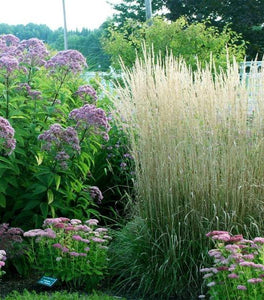
Images Depict Mature Plants
Horsetail Plant for Sale Online
The Horsetail Plant (Equisetum hyemale), also known as Scouring Rush, is a striking, ancient perennial that adds unique texture and vertical interest to gardens and landscapes. With its tall, reed-like stems and deep green coloration, this plant is perfect for creating a modern or naturalistic look in water gardens, ponds, or along borders. Horsetail Plant thrives in USDA Hardiness Zones 4-9, making it suitable for a wide range of climates. It is known for its ability to grow in both full sun and partial shade, as well as its tolerance for wet and boggy soil conditions, making it ideal for rain gardens and erosion control.
Growing to a mature height of 3-5 feet, the Horsetail Plant forms dense clumps that create a striking architectural statement in any landscape. Its distinctive, jointed stems remain evergreen in many climates, providing year-round interest and structure. This plant’s natural spreading habit makes it ideal for use as a living screen or privacy barrier, though it should be planted in a controlled space or container to prevent unwanted spreading in smaller garden areas. Its unique texture makes it a popular choice for modern, minimalist designs, adding height and structure without the need for extensive maintenance.
The Horsetail Plant is not only visually appealing but also highly versatile and resilient. It can thrive in wet soils where other plants might struggle, making it perfect for planting near streams, ponds, or in low-lying areas that retain moisture. Despite its love for moist environments, the Horsetail Plant can also adapt to average garden soils with adequate moisture. Its low-maintenance nature and ability to add bold, vertical accents make it a popular choice for both experienced gardeners and those looking to create a distinctive landscape feature with minimal upkeep.

| Hardiness Zone: | 4-9 |
|---|---|
| Mature Height: | 3 to 4 feet |
| Mature Width: | 2 to 4 Feet |
| Sunlight: | Full sun to partial sun |
| Water Requirements: | Moist to wet |
How to Care for Horsetail Plant
Be sure to read our planting instructions to ensure a healthy and happy Horsetail Plant for years to come!
How Do I Plant Horsetail Plant?
To plant the Horsetail Plant (Equisetum hyemale), start by selecting a location that receives full sun to partial shade and has consistently moist or wet soil. This plant thrives in water gardens, along the edges of ponds, and in rain gardens, as it prefers areas with plenty of moisture. Dig a hole that is slightly wider than the root ball, and plant the horsetail so that the top of the root ball is level with the soil surface. Gently backfill the hole, firming the soil around the roots, and water thoroughly to help the plant establish. If you’re planting in a garden bed, consider using a root barrier or container to prevent the plant from spreading too aggressively, as its rhizomes can expand quickly. When planting Horsetail Plant in containers, choose a pot with drainage holes to ensure excess water can escape, even though the plant prefers moist conditions. Use a rich, water-retentive potting mix that holds moisture well, and place the container in a spot where it will receive adequate sunlight. The Horsetail Plant's adaptability makes it a versatile choice for adding a vertical, striking look to container arrangements on patios or near water features. After planting, keep the soil consistently moist, especially during the initial growing period, to help the plant establish strong roots. Proper planting ensures that your Horsetail Plant thrives, adding its unique texture and form to your landscape.
How Do I Water Horsetail Plant?
Watering the Horsetail Plant (Equisetum hyemale) is straightforward, as this plant thrives in consistently moist or wet conditions. It is well-suited for planting near ponds, streams, or in water gardens where its roots can remain damp. If planted directly in the ground, ensure the soil remains consistently moist by watering regularly, especially during dry spells or hot weather. Horsetail Plant can tolerate standing water, so there’s no need to worry about overwatering; in fact, it thrives in areas where other plants might struggle with excessive moisture. Regular watering helps the plant establish a strong root system, promoting healthy, vigorous growth. For container-grown Horsetail Plants, maintaining adequate moisture is key. Check the soil frequently, as pots tend to dry out more quickly than garden beds. Water the plant whenever the top inch of soil begins to feel dry, ensuring that it remains damp but not waterlogged. Placing the pot in a saucer filled with water can also help keep the soil moist for longer periods, especially during hot summer months. Proper watering will ensure that the Horsetail Plant stays lush and vibrant, with its signature tall, reed-like stems adding a unique vertical element to your container garden or water feature.
How Do I Fertilize Horsetail Plant?
To fertilize the Horsetail Plant (Equisetum hyemale), use a balanced, slow-release fertilizer in the early spring as new growth starts to emerge. A general-purpose formula, such as a 10-10-10 fertilizer, provides the essential nutrients of nitrogen, phosphorus, and potassium, promoting healthy growth and vibrant green stems. Apply the fertilizer evenly around the base of the plant, being careful not to let it come in direct contact with the stems to prevent burning. Water thoroughly after applying the fertilizer to help it penetrate the soil and reach the roots. For plants grown in wet, nutrient-rich soils, such as those near ponds or streams, fertilizing once a year is often sufficient to keep the Horsetail Plant thriving. If you’re growing the Horsetail Plant in a container, it may benefit from more frequent feeding since nutrients can leach out of the soil faster. Use a diluted liquid fertilizer every 4-6 weeks during the growing season, following the package instructions for the correct dilution rate. This will help maintain lush, vigorous growth throughout the spring and summer. Organic alternatives like compost tea or fish emulsion can also be used to provide a steady supply of nutrients. While Horsetail Plant is generally low-maintenance, proper fertilization ensures that it remains healthy and continues to add its unique, upright form and deep green color to your garden or water feature.

How Do I Prune Horsetail Plant?
Pruning the Horsetail Plant (Equisetum hyemale) is an essential part of maintaining its neat, attractive appearance in the garden or water feature. To prune Horsetail Plant, use sharp garden shears or scissors to cut back any damaged, yellowing, or dead stems at their base. This can be done throughout the growing season to keep the plant looking tidy and to encourage fresh new growth. Removing unhealthy stems not only improves the plant's appearance but also allows for better air circulation around the clumps, helping to reduce the risk of mold or mildew, especially in damp environments where Horsetail Plant thrives. In late winter or early spring, perform a more thorough pruning to prepare the Horsetail Plant for the new growing season. Trim back older stems to ground level to make room for the fresh shoots that will emerge as the weather warms. If the plant has spread too much, this is also a good time to thin out the clumps, controlling its size and preventing it from becoming too invasive. Regular pruning ensures that the Horsetail Plant maintains its dense, upright form and continues to provide a striking, vertical element in your landscape, water garden, or along pond edges. Proper pruning will keep your Horsetail Plant healthy, vibrant, and looking its best year-round.















